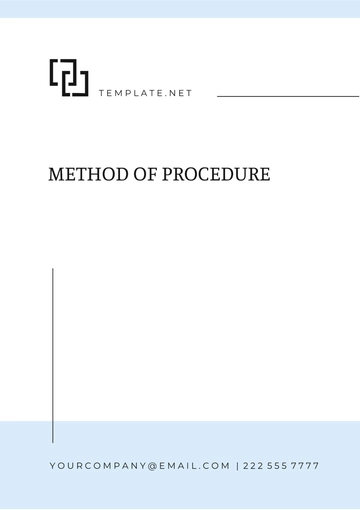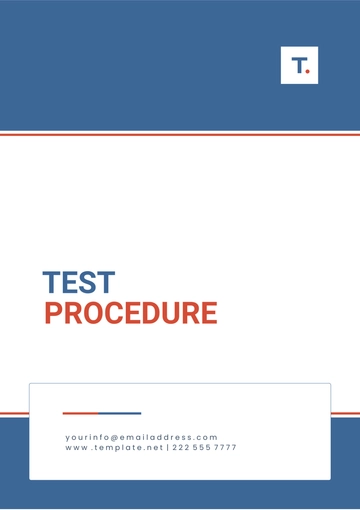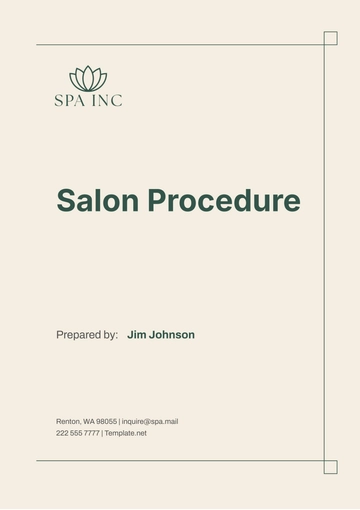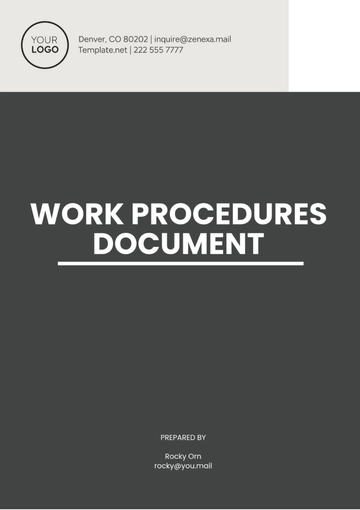Free Hotel Maintenance Procedure

I. Introduction
The purpose of this Hotel Maintenance Procedure document is to establish standardized practices that ensure the operational efficiency, safety, and guest satisfaction of our facilities. Maintenance activities cover all areas of our hotel, including guest rooms, public spaces, kitchens, and mechanical systems. This document outlines the systematic approach to both routine and unexpected maintenance tasks, ensuring a consistent and high-quality guest experience.
II. Maintenance Categories
A. Preventive Maintenance
Preventive maintenance is crucial for avoiding equipment failures and extending the lifespan of our assets. This proactive approach includes regular inspections, adjustments, cleaning, and replacements scheduled to prevent breakdowns before they occur. Key items under preventive maintenance include:
HVAC systems check and filter replacement
Regular inspection and cleaning of roofing and gutters
Elevator servicing and safety checks
Fire safety equipment checks and testing
Plumbing inspections and leak checks
B. Corrective Maintenance
Corrective maintenance involves repairs that are necessary when equipment fails or malfunctions. This reactive maintenance ensures that disruptions are minimized and that facilities are returned to operation as quickly as possible. Items typically requiring corrective maintenance include:
Repairing broken door locks and hinges
Fixing plumbing blockages or leaks
Restoring electrical faults
Replacing damaged furniture or fixtures
Addressing issues with room amenities like TVs or mini-fridges
III. Roles and Responsibilities
Effective maintenance requires a collaborative effort among our team. The following table outlines the specific roles and responsibilities associated with the maintenance procedures:
Role | Responsibilities |
|---|---|
Maintenance Manager |
|
Maintenance Technicians |
|
Housekeeping Staff |
|
Front Desk Staff |
|
IV. Maintenance Procedures
A. Guest Rooms
Regular maintenance in guest rooms ensures comfort and safety for our guests. Our team conducts systematic checks and service according to a predefined checklist to maintain the highest standards of hospitality.
Maintenance Item | Expected Condition | Frequency |
|---|---|---|
HVAC system | Clean, fully functional | Quarterly |
Electrical outlets | Safe, operational | Bi-annually |
Plumbing | Leak-free, functional | Quarterly |
Furniture | Good condition, no damage | Annually |
Safety equipment | Compliant, fully functional | Annually |
Procedures
HVAC System: Check filters and refrigerant levels, clean coils, and test system operations.
Electrical Outlets: Test all outlets and replace any that are faulty or show signs of wear.
Plumbing: Inspect for leaks, clear drains and aerators, and check water heater settings.
Furniture: Inspect for stability and wear, tighten fittings, and repair or replace as necessary.
Safety Equipment: Test smoke detectors and replace batteries, ensure fire extinguishers are accessible and charged.
B. Public Areas
Public areas require frequent maintenance to uphold aesthetics and functionality. This includes lobbies, hallways, conference rooms, and other common spaces.
Maintenance Item | Expected Condition | Frequency |
|---|---|---|
Lighting fixtures | Well-lit, no flickering | Monthly |
Carpets and floors | Clean, no tears or hazards | Weekly |
Furniture | Clean, stable, no visible wear | Quarterly |
Artwork and décor | Securely mounted, undamaged | Bi-annually |
Procedures
Lighting Fixtures: Replace bulbs as needed, clean fixtures, and check for electrical safety.
Carpets and Floors: Vacuum carpets, mop floors, and check for trip hazards.
Furniture: Clean surfaces and upholstery, repair any damage, and tighten loose components.
Artwork and Décor: Dust and clean all pieces, ensure secure mounting.
C. Kitchens
Maintenance in the kitchen is critical for safety and operational efficiency, focusing on appliances and cleanliness.
Maintenance Item | Expected Condition | Frequency |
|---|---|---|
Cooking equipment | Clean, fully functional | Daily |
Refrigeration units | Proper temperature, clean | Daily |
Exhaust systems | Free of blockages, functional | Monthly |
Fire suppression systems | Fully operational | Semi-annually |
Procedures
Cooking Equipment: Deep clean surfaces and components, check and calibrate thermostats.
Refrigeration Units: Check temperature settings, clean coils, and inspect door seals.
Exhaust Systems: Clean filters and check for unobstructed airflow.
Fire Suppression Systems: Inspect and test to ensure functionality in case of emergency.
D. Technical Equipment
Technical equipment such as boilers, elevators, and generators require rigorous maintenance to prevent failures and ensure safety.
Maintenance Item | Expected Condition | Frequency |
|---|---|---|
Boilers | Optimal operation, safe | Annually |
Elevators | Smooth operation, compliant | Semi-annually |
Generators | Ready condition, fuel levels adequate | Quarterly |
Procedures
Boilers: Inspect for leaks, test safety valves, and perform efficiency tests.
Elevators: Lubricate moving parts, inspect doors and emergency calls, and conduct safety tests.
Generators: Test run under load, check and replace old fuel, inspect and clean components.
VI. Documentation and Record Keeping
Accurate documentation and record keeping are essential components of our maintenance program. These records help track the history of equipment, validate warranties, and ensure compliance with safety regulations.
Create Maintenance Logs: For each maintenance task completed, log the date, details of the work performed, personnel involved, and any parts used.
Update Asset Registers: Regularly update asset registers to reflect any additions, disposals, or changes in equipment condition.
Maintain Safety Records: Keep detailed records of all safety inspections and certifications to ensure ongoing compliance and readiness for audits.
Archive Documentation: All maintenance records should be securely archived for a minimum of five years for referencing in case of warranties, disputes, or for historical data analysis.
VII. Training and Development
Continuous training and development are critical to maintaining the expertise and safety awareness of our maintenance team.
Program | Frequency | Duration |
|---|---|---|
Basic Maintenance Skills | Annually | 8 hours |
Advanced Technical Training | Bi-annually | 16 hours |
Safety and Compliance | Quarterly | 4 hours |
Emergency Response Training | Annually | 8 hours |
VIII. Evaluation and Improvement
Evaluating the effectiveness of our maintenance procedures allows us to identify areas for improvement and implement changes to enhance our operations. We conduct regular reviews of our maintenance logs, guest feedback, and team suggestions to measure performance and adjust our processes accordingly. Annual audits by external inspectors also provide objective assessments of our practices and prompt improvements.
IX. Emergency Procedures
In the event of an emergency, having clear and practiced procedures in place is crucial for the safety of both guests and staff.
Immediate Response: Maintenance staff are trained to immediately assess and respond to emergencies, such as power failures or plumbing leaks.
Evacuation Procedures: Clear evacuation protocols for different scenarios (fire, flood, etc.) are established and communicated.
Emergency Contact Lists: Maintain up-to-date emergency contact lists including local authorities, repair services, and management.
Backup Systems: Ensure all backup systems, like generators and water pumps, are operational and can be activated quickly.
X. Ongoing Diligence
We encourage all team members to maintain ongoing diligence in their maintenance responsibilities. Regular attention to detail, proactive identification of potential issues, and a commitment to continuous improvement are the keys to maintaining the high standards of our hotel’s operations and guest satisfaction. Each staff member’s dedication to these principles ensures our hotel remains a safe, comfortable, and welcoming environment for all our guests.
- 100% Customizable, free editor
- Access 1 Million+ Templates, photo’s & graphics
- Download or share as a template
- Click and replace photos, graphics, text, backgrounds
- Resize, crop, AI write & more
- Access advanced editor
Keep your hotel in top condition with Template.net's customizable Hotel Maintenance Procedure Template. Designed to guide your maintenance team through standard practices and schedules, this template is fully editable in our AI Editor tool. Ensure consistent upkeep and prolong the lifespan of your facilities with a clear, systematic approach.





























